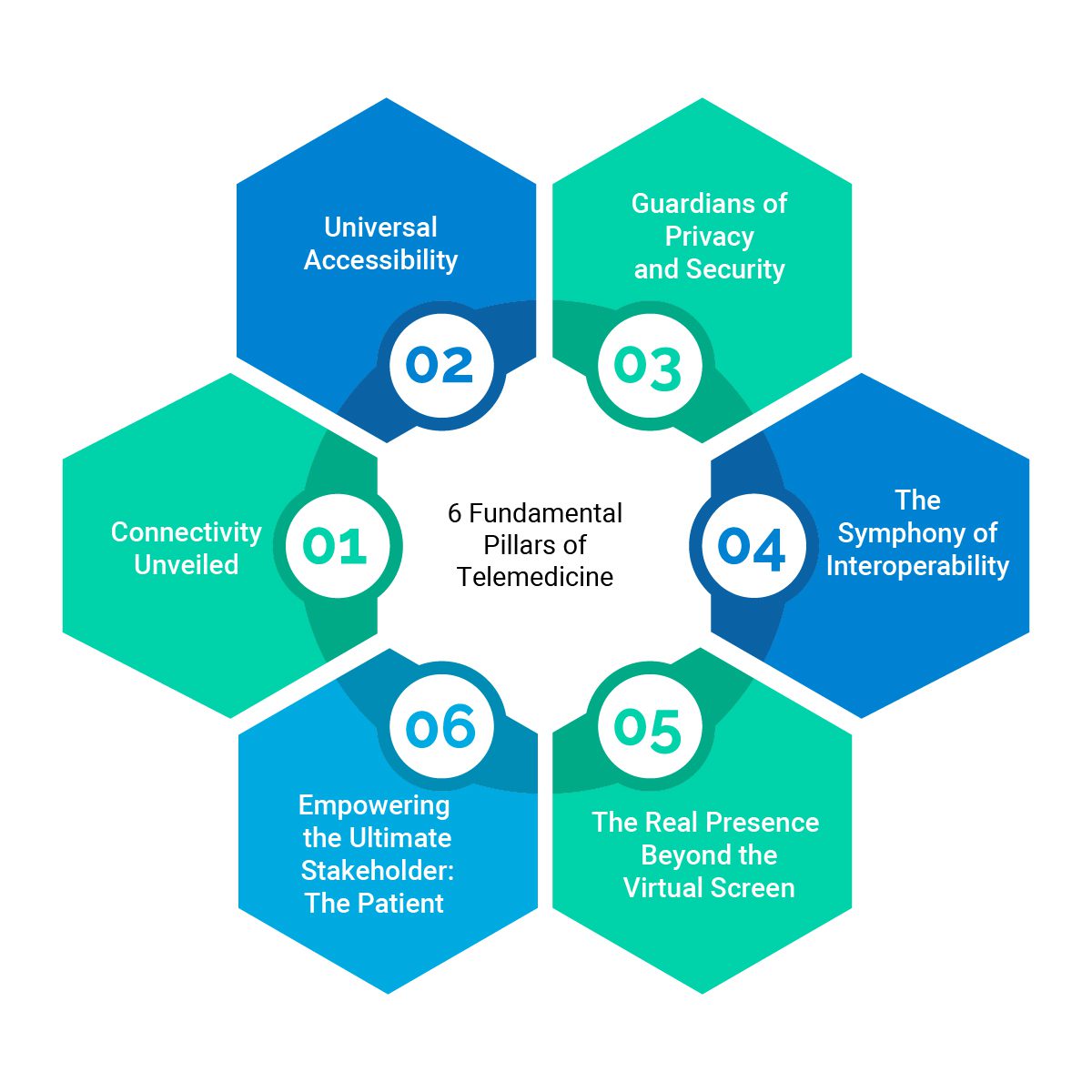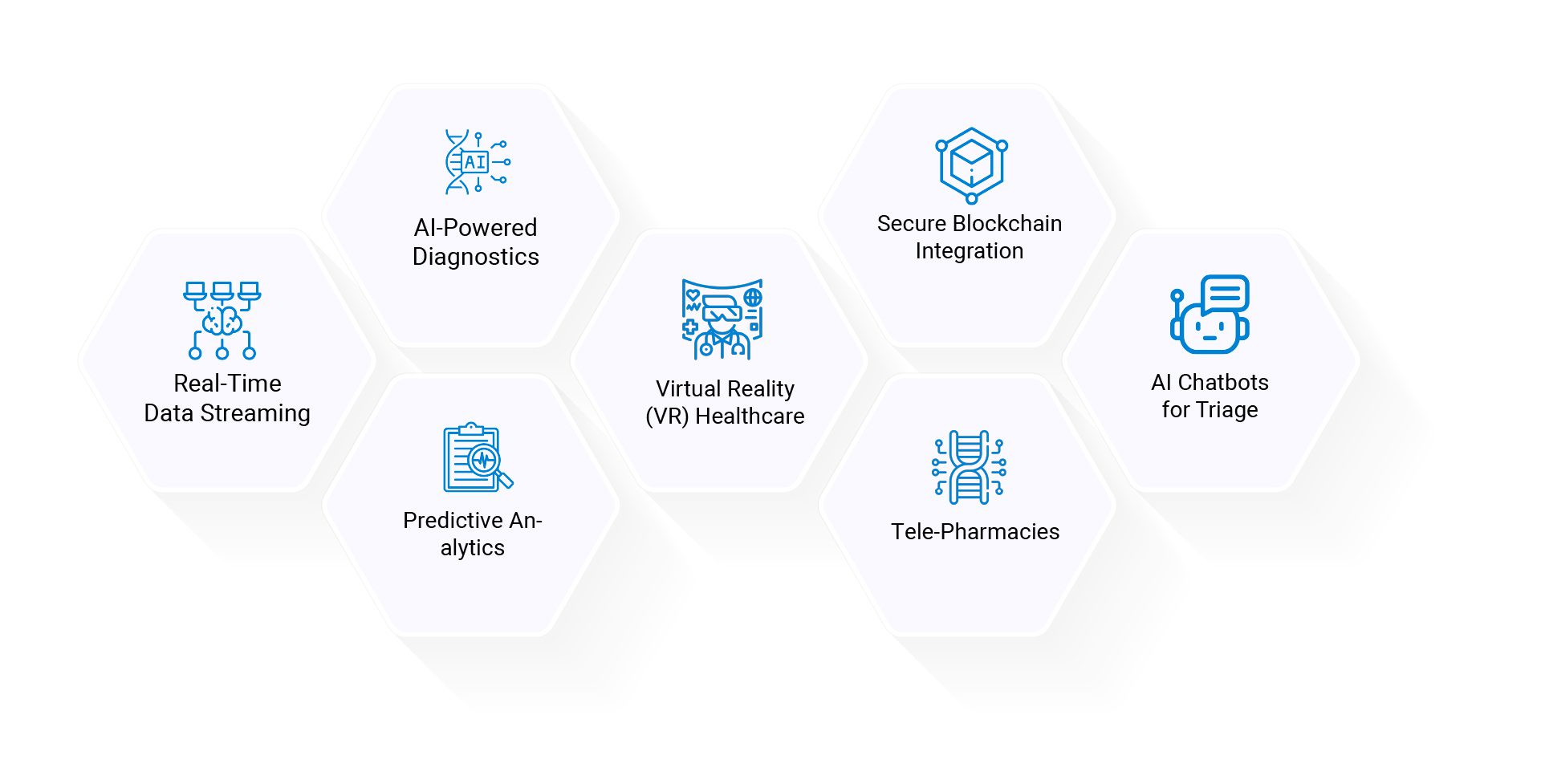Highlights:
- Telemedicine is in the midst of a groundbreaking revolution, with its growth fueled by rising healthcare costs, an aging population, and global health crises.
- Six core pillars underpin telemedicine, delivering universal accessibility, robust data security, seamless interoperability, real presence, and patient empowerment for comprehensive and patient-centric care.
- Microsoft Azure is a transformative force in healthcare, making quality care accessible, even in remote areas. It’s reshaping healthcare delivery, enhancing patient outcomes, and offering innovative solutions.
- Leading healthcare institutions, including the Mayo Clinic, Intermountain Healthcare, Partners Healthcare, UCSF, and the Department of Veterans Affairs (VA), are successfully implementing Azure-based telemedicine solutions, elevating accessibility and care quality.
- Microsoft’s collaboration with Data Dynamics, through the Azure File Migration Program, streamlines data migration to Azure, overcoming challenges and fully unleashing the potential of cloud computing for enterprises.
In this Quick Byte:
In today’s fast-paced world, the demand for accessible and convenient healthcare services has never been higher. Over the past decade, the telemedicine industry has witnessed remarkable growth, revolutionizing the way healthcare is delivered and accessed. At the heart of this transformation is cloud technology, which has enabled healthcare providers to break down geographical barriers and make quality healthcare services available to anyone, anywhere. In this article, we will delve into the fascinating journey of cloud-based telemedicine solutions, exploring its impact on healthcare accessibility and innovation and Azure’s role in accelerating this transformation.
The Telemedicine Revolution
The growth of telemedicine can be described as nothing short of revolutionary. Its roots date back to the late 1950s when telephonic consultations between healthcare professionals and patients first began. However, it was only in recent years that telemedicine saw an unprecedented surge in popularity. Factors such as increasing healthcare costs, an aging population, and the need for social distancing during global health crises, like the COVID-19 pandemic, have accelerated the adoption of telemedicine. The telemedicine industry’s rapid growth is a story of technological innovation, changing healthcare needs, and an evolving understanding of the possibilities of remote healthcare delivery.
- Early Beginnings: Telemedicine’s roots can be traced back to the late 1950s when medical professionals began experimenting with telephonic consultations. The National Aeronautics and Space Administration (NASA) played an instrumental role in the development of telemedicine by using technology to monitor astronauts’ health during space missions.
- Emergence of Telehealth: The concept of telehealth, an umbrella term encompassing telemedicine, gained traction in the 1970s and 1980s. The development of video conferencing technology allowed physicians to see and diagnose patients remotely, marking a significant advancement in the field.
- The Internet Era: With the proliferation of the Internet in the 1990s, telemedicine gained even more momentum. This new connectivity allowed for secure data transfer and real-time video consultations, making it more practical and effective. The establishment of dedicated telemedicine networks and services further fueled its growth.
- Telemedicine in Remote Areas: Telemedicine quickly became an essential tool for addressing healthcare disparities in remote and underserved areas. In countries with vast rural regions, like the United States and Australia, telemedicine helped bridge the gap by enabling patients in remote locations to access healthcare without the need for extensive travel.
- Chronic Disease Management: The early 2000s witnessed an expansion of telemedicine into chronic disease management. It provided a lifeline for individuals with long-term health conditions who required ongoing care and monitoring. Devices like remote patient monitoring equipment allow patients to take vital readings and share them with healthcare providers in real-time.
- Telemedicine Adoption Surges: The 2010s marked a turning point in the telemedicine industry’s growth. The combination of improved technology, changes in reimbursement policies, and the increasing acceptance of virtual care by patients and providers led to exponential growth. It was during this decade that telemedicine became more widely accepted and integrated into mainstream healthcare practices.
- Global Health Crises and Telemedicine: The COVID-19 pandemic, which began in late 2019, served as a major catalyst for the telemedicine industry. The need for social distancing and reduced in-person contact pushed telemedicine to the forefront of healthcare delivery. In response to the pandemic, governments and healthcare organizations around the world quickly expanded their telemedicine offerings to ensure continuity of care.
The rapid expansion of the telemedicine industry is a testament to its ability to adapt and meet the evolving healthcare needs of society. It has demonstrated its potential to improve healthcare accessibility, reduce healthcare disparities, and increase the convenience of medical services. As technology continues to advance and healthcare delivery models evolve, the telemedicine industry will remain a driving force in the future of healthcare.
Six Fundamental Pillar of Telemedicine
Telemedicine’s cornerstone extends beyond the conventional perception of connectivity. It’s not merely a technical requirement; it’s the digital nexus that propels healthcare into an era of transformative innovation. Delving deeper into this fundamental pillar reveals a multidimensional landscape that reshapes the very essence of patient care.

- Connectivity Unveiled: At its essence, telemedicine is a symphony of seamless communication. It transcends the boundaries of distance, time zones, and physical presence. Beyond the visual interface of video calls, telemedicine hinges on the intricate exchange of critical medical data. It’s about electronic prescriptions, remote monitoring, and the real-time transmission of vital patient information. In essence, connectivity ensures that the dialogue between patient and healthcare provider flows uninterrupted, irrespective of physical distances.
- Universal Accessibility: Telemedicine’s connectivity extends its benevolent hand to the farthest reaches of society. It’s a commitment to inclusivity. The transformation it brings is not confined to bustling urban centers with high-speed internet. Instead, it spreads its wings to the remotest and underserved corners of the globe. This inclusivity is the essence of telemedicine, ensuring that healthcare is a fundamental right accessible to every individual, regardless of their location.
- Guardians of Privacy and Security: In an age where data breaches and privacy concerns cast a looming shadow, telemedicine’s connectivity takes on the role of a guardian. The transmission of sensitive patient data demands an unwavering commitment to data security and privacy. The digital channels through which healthcare information flows are fortified with state-of-the-art encryption and security protocols. Patient confidentiality becomes non-negotiable, and data integrity is the bedrock upon which telemedicine stands.
- The Symphony of Interoperability: Connectivity in telemedicine reaches beyond individual healthcare systems; it’s the maestro orchestrating interoperability. Telemedicine platforms aim to create a harmonious environment where healthcare providers, regardless of their affiliations, can exchange patient records, test results, and crucial medical data seamlessly. This interoperability weaves a comprehensive tapestry of patient care, ensuring that all medical professionals involved have access to a complete medical history.
- The Real Presence Beyond the Virtual Screen: In telemedicine’s digital realm, connectivity is the bridge between virtual presence and tangible healthcare. It is the conduit to specialists, experts, and even remote monitoring devices. Beyond video consultations, data from wearable health sensors and remote monitoring devices is transmitted securely through these connections. This convergence of virtual and physical presence creates a holistic understanding of the patient’s health, transcending the confines of traditional healthcare.
- Empowering the Ultimate Stakeholder: The Patient: The ultimate essence of telemedicine’s connectivity is the empowerment of patients. It opens a direct channel between patients and healthcare professionals, fostering an environment where individuals actively engage in their health journeys. It shifts patients from passive recipients of care to active participants, equipped with knowledge, access, and agency to shape their healthcare destinies.
These six fundamental pillars of telemedicine have emerged as beacons of convenience, accessibility, and patient-centered care. They are reshaping the healthcare landscape, offering solutions that transcend geographical barriers and bridge the gap between patients and providers. One player has taken center stage and is revolutionizing the healthcare industry as we know it. Microsoft Azure, the tech giant’s cloud computing platform, has emerged as a game-changer by providing an extensive range of cloud-based solutions that are reshaping the entire healthcare landscape. This shift is not just about making healthcare more convenient; it’s about fundamentally transforming the way we approach, access, and improve healthcare. Microsoft Azure is ushering in significant advancements in healthcare accessibility, patient engagement, diagnostics, and overall quality of care.
Azure’s Impact on Telemedicine: Bridging Divides and Revolutionizing Patient Care
Microsoft Azure’s influence goes beyond mere convenience. It is fundamentally altering how healthcare is perceived and approached. By providing innovative tools and platforms, Azure is making healthcare more accessible than ever before. A prime example is a scenario where a rural community, previously underserved due to geographical constraints, now has access to top-tier medical consultations. Azure’s cloud infrastructure enables healthcare providers to deliver quality care to remote and marginalized areas, effectively bridging the healthcare divide that has long plagued our society. Healthcare today is just a click away, and it’s available when and where it’s needed.
Let’s delve into some of the key ways Azure is making a difference:

- Real-Time Data Streaming: Azure’s IoT Hub and Event Hubs have redefined the integration of real-time health data from wearable devices. A patient with a chronic condition can now monitor their health in real-time and transmit this data to their healthcare provider. Azure’s capabilities empower healthcare professionals to continuously track patients’ health status, detect anomalies, and intervene as needed, resulting in improved health outcomes, reduced hospital admissions, and lower healthcare costs. A study published in the Journal of Medical Internet Research found that real-time monitoring of chronic conditions using IoT technology can reduce hospital admissions by up to 35% and lower healthcare costs by 26%.
- AI-Powered Diagnostics: Azure’s machine learning capabilities have ushered in a new era of AI-powered diagnostics. Picture a scenario where an AI algorithm, trained on vast medical datasets, assists radiologists in swiftly and accurately identifying anomalies in medical images. Azure’s machine learning tools are driving the development of AI models for medical image analysis, diagnostic support, and predictive analytics, leading to quicker and more precise diagnoses, reducing the burden on healthcare professionals, and improving patient outcomes. Research conducted by the American College of Radiology indicates that AI-powered diagnostic tools have increased radiologists’ accuracy in identifying anomalies by 20% and reduced the time required for diagnoses by 30%.
- Predictive Analytics: Azure’s big data and analytics tools have become indispensable in predictive healthcare analytics. Consider a healthcare system that can predict disease outbreaks or identify high-risk patient groups with incredible accuracy. With Azure’s support, organizations can harness the power of predictive analytics to anticipate health trends, allocate resources efficiently, and reduce the strain on healthcare systems, ultimately improving the quality of care. The Centers for Disease Control and Prevention (CDC) reported that predictive analytics tools can anticipate disease outbreaks with a lead time of up to 2 weeks, allowing for more timely and effective interventions.
- Virtual Reality (VR) Healthcare: Azure’s capabilities extend to virtual reality (VR) applications for healthcare, offering immersive experiences with significant therapeutic potential. For instance, a patient recovering from surgery can use VR therapy to manage pain and aid rehabilitation. Azure’s mixed reality services, including HoloLens, are instrumental in developing VR applications for pain management, physical therapy, and behavioral therapy, enhancing patient engagement, and expediting recovery. A study published in the Journal of Pain Research found that VR therapy can reduce pain scores by an average of 30% and decrease the need for pain medication in post-surgery patients.
- Secure Blockchain Integration: Data security in healthcare is paramount, and Azure’s blockchain services have entered the fray. Think about the critical need for the secure and immutable storage of electronic health records (EHRs). Azure’s blockchain capabilities are paving the way for tamper-proof EHRs, ensuring data integrity and patient privacy in an era where data breaches are a prevalent concern. According to a survey by the Healthcare Information and Management Systems Society (HIMSS), healthcare organizations that have implemented blockchain for electronic health records (EHRs) have reported a 30% reduction in data breaches.
- Tele-Pharmacies: Azure’s cloud services aren’t limited to clinical care alone; they also support the growth of tele-pharmacies, a sector poised for substantial expansion. Imagine the convenience of consulting with a pharmacist remotely, ensuring accurate medication management and healthcare education. Azure’s role in bolstering tele-pharmacies is invaluable, especially in a world where patient-centric care and convenience are of utmost importance. The American Telemedicine Association reports that tele-pharmacies have grown by 200% in the past five years, and patients using tele-pharmacy services have reported an average satisfaction rating of 4.8 out of 5.
- AI Chatbots for Triage: Azure’s Cognitive Services, driven by AI, power chatbots for patient triage, making healthcare interactions more efficient and patient-centric. Consider a scenario where a patient initiates a conversation with an AI chatbot to describe their symptoms. The chatbot, powered by Azure’s natural language processing capabilities, intelligently assesses the patient’s condition, streamlines the intake process, and directs them to the appropriate healthcare resource, ensuring swift and accurate care. A case study conducted by a major healthcare provider showed that AI chatbots reduced the average patient triage time by 50%, resulting in faster access to care and improved patient satisfaction.
Let’s now check out 5 healthcare organizations that have implemented Azure Telemedicine Solutions
The prestigious Mayo Clinic has partnered with tech giant Microsoft to unveil a state-of-the-art telemedicine platform. This innovative system harnesses the capabilities of Microsoft Azure’s cloud computing to offer patients a secure, efficient, and user-friendly telehealth experience. Gone are the days of inconvenient in-person doctor visits, as patients can now seamlessly connect with healthcare professionals through secure video conferencing. This not only adds convenience to the equation but also maintains the highest standards of privacy and data security.
Moving westward to Utah, we find Intermountain Healthcare, a prominent healthcare system that has embraced the power of Microsoft Azure’s cloud technology to establish a comprehensive telemedicine program. This initiative goes beyond the basics, offering a diverse range of services, from mental health counseling to the management of chronic diseases and pre-operative consultations. The scalability and robust security features of Azure ensure that patients have easy access to essential healthcare services from the comfort of their own homes, thereby enhancing both accessibility and the quality of care.
Heading east to Massachusetts, Partners Healthcare, a non-profit healthcare system, has introduced an all-encompassing telemedicine program designed to cater to patients with a wide array of medical conditions, including stroke, heart failure, and sepsis. Azure’s cloud infrastructure forms the rock-solid foundation for this program, delivering reliability and security for telehealth services. Through Partners Healthcare, patients can now receive timely and effective care for even the most critical medical conditions, regardless of their physical location.
Further down the coast, at the University of California, San Francisco (UCSF), the healthcare arm of the university has rolled out an advanced telemedicine program covering a multitude of medical specialties, including dermatology, cardiology, and oncology. Azure’s cloud capabilities play a pivotal role in ensuring the security and scalability of these telemedicine services. Patients can now tap into the expertise of UCSF healthcare professionals through virtual consultations, making specialized medical care more accessible and convenient.
Lastly, for our nation’s veterans, the Department of Veterans Affairs (VA) has taken significant strides to enhance the healthcare experience by implementing a robust telemedicine program. This program is tailored to address a wide range of conditions, from mental health concerns to chronic disease management and post-traumatic stress disorder (PTSD). Microsoft Azure’s cloud infrastructure stands as the cornerstone of this telemedicine initiative, providing a secure and reliable platform for veterans to access critical healthcare services remotely. This, in turn, addresses their unique healthcare needs with unmatched efficiency and dependability.
In a world where healthcare is constantly evolving, Microsoft’s Azure is proving to be a transformative force, democratizing access to quality care and revolutionizing the way we approach patient health and well-being. With these advancements, the future of healthcare is looking brighter and more accessible for all.
The Data Dynamics Advantage
The realm of cloud computing garners significant interest, yet the initial step of data migration often proves to be a stumbling block on the path to reaping its benefits. Manual processes and budget constraints frequently hinder the progress of cloud initiatives. To surmount these challenges, organizations require automated, scalable solutions for transferring their data to the cloud.
This is where Microsoft, in collaboration with Data Dynamics, introduces the Azure File Migration Program—a transformative solution for enterprises keen on migrating their data to Azure at no cost. This partnership empowers organizations to seamlessly transition their unstructured files and object storage data to Azure, alleviating concerns about expenses or additional migration licenses. Our automated migration process not only mitigates risks but also maintains granular control over access and file security, preserving the integrity of your data.
However, the synergy between Microsoft and Data Dynamics encompasses more than data migration. It champions intelligent data management across On-Premise, Azure, and Hybrid Cloud environments, bolstering overall efficiency and effectiveness. Through this program, customers can register their migration projects with Data Dynamics and commence the seamless movement of their data to Azure right away.
What sets Data Dynamics apart is our comprehensive platform, offering a spectrum of features that facilitate intelligent data tiering to Azure. We deliver automated methods for migrating data, allowing for the seamless migration of individual files, folders, shares, or entire volumes from on-premises storage to Azure. Our policy-based data tiering empowers you to create rules that automatically transition data to different storage tiers based on its usage patterns, optimizing costs and ensuring that data resides in the most fitting tier. Data governance stands as another vital facet, as our platform enables the implementation of policies that enforce data security measures, before storing data in Azure—assuring compliance with regulatory requirements.
The Azure File Migration Program, powered by Data Dynamics, squarely addresses the critical challenges that surface during the journey of cloud migration. It adeptly tackles issues related to cost, speed, talent, and risk, aiding organizations in navigating the complexities and fully unlocking the potential of cloud computing.
To delve deeper into the world of Data Dynamics and discover how our platform can facilitate seamless data migration, efficient data management, and cost optimization within Azure, please visit our website at https://www.datadynamicsinc.com/microsoft/. Additionally, you can reach out to us at solutions@datdyn.com or connect with us via phone at (713)-491-4298 or +44-(20)-45520800. Allow us to become your trusted partner on your cloud migration and data management journey.






